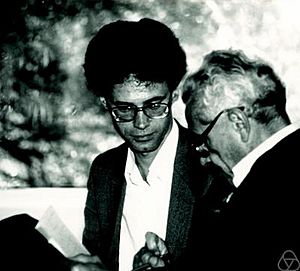Roger Heath-Brown facts for kids
Quick facts for kids
Roger Heath-Brown
|
|
|---|---|

Heath-Brown in 1986
|
|
| Born | 12 October 1952 |
| Citizenship | United Kingdom |
| Alma mater | University of Cambridge |
| Known for | Analytic number theory, Heath-Brown–Moroz constant |
| Awards | Smith's Prize (1976) Berwick Prize (1981) Fellow of the Royal Society (1993) Senior Berwick Prize (1996) Pólya Prize (2009) Sylvester Medal (2022) |
| Scientific career | |
| Fields | Pure mathematics |
| Institutions | University of Oxford |
| Thesis | Topics in Analytic Number Theory (1979) |
| Doctoral advisor | Alan Baker |
| Doctoral students | Timothy Browning Timothy Trudgian James Maynard |
Roger Heath-Brown is a British mathematician. He is known for his work in a special area of math called analytic number theory. This field uses tools from analysis to study numbers, especially prime numbers.
Contents
Education and Early Career
Learning at Cambridge
Roger Heath-Brown studied at Trinity College, Cambridge. He went there for both his first degree and his advanced studies. His main teacher and guide for his research was a famous mathematician named Alan Baker.
Working as a Professor
In 1979, Roger Heath-Brown started working at the University of Oxford. From 1999, he became a professor of pure mathematics there. He retired from his teaching role in 2016.
Key Discoveries in Mathematics
Roger Heath-Brown is famous for many important discoveries in math. He has solved some very tricky problems.
Understanding Prime Numbers
He proved that there are endless prime numbers that can be written in a special way. This way is x3 + 2y3. This was a big step in understanding how prime numbers are formed.
Working with Other Mathematicians
In 1978, he worked with S. J. Patterson. Together, they proved a long-standing idea about something called Kummer sums. This helped mathematicians understand how these sums are spread out.
Solving Equations
He also showed that certain complex equations, called non-singular cubic forms, can always be solved. This is true if they have at least ten variables. These equations are studied using rational numbers.
Linnik's Constant
Heath-Brown also helped to make Linnik's constant smaller. This constant is important in understanding how prime numbers are spaced out. He showed it was less than or equal to 5.5.
The Determinant Method
More recently, Roger Heath-Brown became known for a new way of solving problems. This is called the "determinant method." Using this method, he proved a guess made by another mathematician, Serre, in 2002. This guess was about how many special points exist on certain shapes in math. It was later called the "dimension growth conjecture." By 2009, he and other mathematicians had almost completely solved this puzzle.
Awards and Recognition
Roger Heath-Brown has received many important awards for his work.
Prizes for Mathematics
The London Mathematical Society has given him several awards. These include the Junior Berwick Prize in 1981 and the Senior Berwick Prize in 1996. He also received the Pólya Prize in 2009.
Fellowships and Memberships
In 1993, he became a Fellow of the Royal Society. This is a very high honor for scientists in the United Kingdom. In 1999, he also became a member of the Göttingen Academy of Sciences in Germany.
Speaking at Conferences
He was asked to speak at the International Congress of Mathematicians twice. First in 1983 in Warsaw and again in 2010 in Hyderabad. He spoke about "Number Theory" at both events.
American Mathematical Society
In 2012, he became a fellow of the American Mathematical Society. This shows his importance in the math community worldwide.
Sylvester Medal
In 2022, the Royal Society gave him the Sylvester Medal. This award was for his many important contributions to studying prime numbers. It also recognized his work on finding solutions to equations using whole numbers.
Order of the British Empire
In the 2024 New Year Honours, Roger Heath-Brown was made an Officer of the Order of the British Empire (OBE). This award recognized his great service to mathematics and mathematical research.
Other Contributions
In September 2007, he helped write the introduction for a famous math book. This book is called An Introduction to the Theory of Numbers. It was written by G.H. Hardy and E.M. Wright. He co-authored the preface with Joseph H. Silverman.

